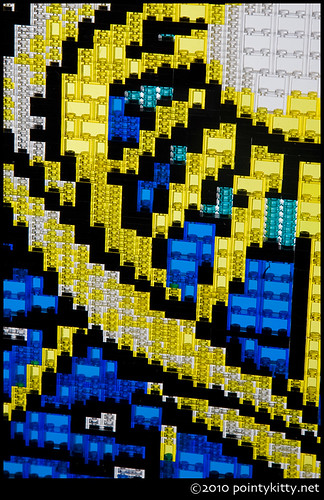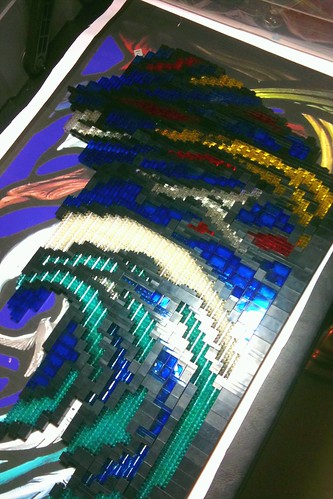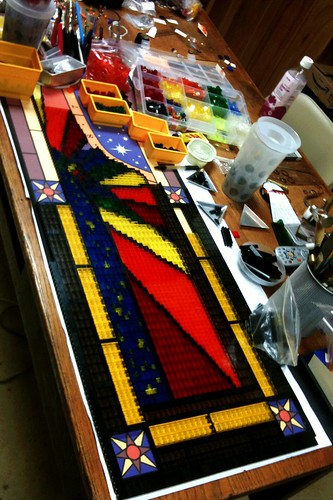
GodBricks: Could you tell us a little bit about yourself, including the background of your interest in art and in LEGO?
Alyska Bailey Peterson: My arts background is a bit varied – I have degrees in documentary film production and commercial photography, worked professionally for about a decade in marketing and event photography, and now have been focusing my studio's offerings on two particular niches: earthy, handmade gemstone and metalsmithed jewelry, and more recently, jury slides and marketing/branding materials for other artists.
I’ve been interested in Legos since I was a kid, and used to beg for them instead of the “girl toy” in my McDonalds Happy Meals, but I really started exploring the medium and working with them again a couple of years ago after hearing about my friends’ and partners’ experience at the Brickworld convention in Chicago, IL.
When trying to decide what sort of building I wanted to get back into, one of them joked about me “liking to do things the hard way,” after I mentioned building in Modulex, and I settled on transparent bricks as something challenging (I like a challenge!) but still mostly-accessible.
GB: We've featured a number of your LEGO renditions of stained glass windows here on GodBricks. Did you first become interested in these for their artistic merit, their religious significance, or some combination of these?
ABP: My first exposure to stained glass work was in churches, first as a young child, but especially when, as a teen, my youth group attended services of different denominations and faiths to help us better understand the context of each group’s belief systems.
The windows were striking examples of visual storytelling, which was a huge draw for me, and I found it interesting that despite the widely varying belief systems of the different services we attended (both in their message, and the manner in which they were communicated to their followers), these colorful glass window-stories were a common thread between all of them.
My grandfather was also a self-taught stained glass artisan, and had just started teaching me the craft when he passed away about a decade ago. While I have never attained any proficiency at actual stained glass work, I often wonder what he would think of my Lego renditions.
GB: Tell us about the Survivors of Trauma window. What drew you to this piece? What is it's significance to you?
ABP: This window was significant to me for a number of different reasons. The tree of life itself has long been important to me as a metaphor for the interconnectedness of all life on our planet and for the livelihood and resilience of the human spirit. The majority of my family tree also originates in Ireland.

When I was able to discern the actual geographic location of the window and read the Survivors of Trauma Center’s mission “to assist those affected by the troubles in North Belfast and help them transition from victims to survivors, empowering them to become vibrant once again,” there was an additional layer of meaning for me, as I am a trauma survivor myself.
GB: How about the creation series? How did you choose to take on this project?
ABP: The theme for the 2011 Brickworld convention is “Five,” and so I started looking for something that I could work on in a series. After flipping through a number of books, and looking at pictures online, I came across Aidan McRae Thomson’s Creation series on their Flickr stream while looking at other religious stained glass windows in Ireland and Great Britain.

The windows were gorgeous – visually striking, and I thought they’d translate well into Lego. The only problem is that there are six days in the Creation Story!
As I went through Thomson’s images of his work, it was that final day, the creation of man and beasts, that would be the most difficult to translate into Lego due partly to the color palette, but moreso due to all of the painting on the glass!
I’ve noodled around some with trying to find a way to do justice to translating that final panel into Lego, but haven’t found anything satisfactory yet, and I’m a terrible perfectionist.
GB: Is there a particular day of creation that is your favorite? Or one that is a particular challenge?
ABP: I like all of them for different reasons, but I think Day Four, the Sun & Moon panel is my favorite.

As for the most challenging? That would have to be Day One: Light and Dark.

The building of the piece itself was no more difficult than any of the other panels, but the transparent purple and transparent light blue bricks are nearly a decade out of print, so I’ve spent the better part of a year repeatedly clearing out the secondary market on multiple continents to simply get enough pieces to complete the piece!
GB: At some points in your stained glass recreations you use transparent bricks, and at other points you use transparent plates, to get a different texture effect. How did you come upon this technique?
ABP: Mostly, by necessity. In some cases, not all parts come in all colors. In other cases, I used plates instead of bricks to either attain more detail or smoother lines, or to create deeper or lighter colors.

When I started with the creation windows, I realized that I’d need to be even more creative than working in a brick-and-plate-only palette to achieve some of the necessary colors, and started working in round bricks and plates, cones, tiles, and cheese wedges to help vary textures and colors.

GB: Centuries ago, stained glass windows in churches served a didactic purpose to teach a largely illiterate congregation stories from the Bible, or of the saints. Does your work have any message?
ABP: I don’t have any specific message attached to the pieces I do, aside from showing that Lego is a creation and building medium that can be utilized long after your teen years, and is limited only by what you, the creator, can come up with.
I love all of the sets that Lego produces, but find it really remarkable what happens when some really creative people set aside the instruction books, and just..build. Put us all in a room together, and it’s amazing the sorts of things we create.
GB: What's next for you in this area? Are you planning on doing day 6? Do you have other stained glass windows in mind?
ABP: In addition to the Creation series, I’m currently finishing up a large 2x4’ stained glass spectrum sundial to exhibit at Brickworld 2011 in Chicago, IL, in June.

After that, I’m looking at doing the “Scientists and Technicians Window” at the Washington National Cathedral in Washington, D.C. It’s on the south side of the cathedral, just west of the tomb of Woodrow Wilson.

The window commemorates America’s exploration of space and man’s first steps on the moon. In the upper center of the window is a 7.18-gram basalt lunar rock from the Sea of Tranquility!
Once again, a huge thanks to Alyska, both for the interview and also for sharing her wonderful MOCs with us. If you're going to BrickWorld in Chicago next month, be sure to check out her work in person.
No comments:
Post a Comment